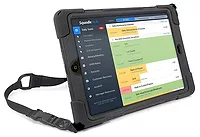How Digital Checklists Drive Safer Employee Behaviors

Digital checklists and similar solutions may be the future of food safety in commercial kitchens, but food safety practices still rest in the hands of human workers.
That may give many restaurant managers and executives pause, given that employees can often be the weak link in the food safety chain. According to industry analysts at Alchemy Systems, over two-thirds (67 percent) of commercial kitchens say that not all of their employees adhere to their food safety programs. The main reasons include inadequate training and a lack of employee understanding of food safety practices.
Thankfully, implementing digital food safety solutions can help here too, by pushing—and, in some ways, forcing—employees to modify their behaviors in ways that make the food they prepare and serve safer.
First, digital checklists help workers become better at food safety.
Whether workers don’t know what they’re supposed to be doing, or just plain aren’t doing it, basic food safety practices sometimes lapse. For example, an Environment Health Services study from the U.S. Centers for Disease Control and Prevention found that “over half of those who cooked food did not usually use a thermometer to check if food was done.”
In a pencil-and-paper world, managers and executives have no way to pinpoint where—and with whom—such failures are occurring.
Enter digitization. With every entry on a digital solution stamped according to person, place, and time, it becomes a snap to zero in on problem areas and workers. With that information, restaurants can provide additional training as needed to ensure that every worker understands and complies with food safety practices.
Looking for quick answers on food safety topics?
Try Ask FSM, our new smart AI search tool.
Ask FSM →
Second, digital checklists help workers become better at their jobs.
Beyond triggering food safety actions with reminders, a digital checklist itself can incorporate feedback, visuals cues, and corrective prompts right into the app, so feedback can be instantaneous.
Is the employee about to miss the checklist? The system can send them or their manager an alert. Does the employee not know how to perform a check? The system can provide on-screen instructions, including visual images. Does the employee try to skip an item? The system won’t let them move forward. Is an entry out of spec? The system can prompt corrective actions (e.g., try re-stirring the soup to re-distribute heat, then temperature check again). Through this kind of repetitive education, the digital solution can drive consistent and appropriate behavior.
These features also mean that digital checklists can enable restaurants to be more cost-effective about how they utilize their workforce.
Specifically, at many restaurants, it’s the manager who conducts most checklists, because the checks may be too advanced or too important for an entry-level worker. But this pushes a mostly rote task onto one of the highest cost resources in the restaurant. With a well-designed digital food safety system that’s as simple as swiping and that incorporates instructions and prompts, lower-level staff can confidently complete checklists. That can turn even minimum wage workers into more cost-effective and resource-efficient members of the team.
Third, digital checklists help keep workers honest.
Doubts about employee integrity may be well-founded, particularly in a high-turnover industry where employee loyalty may be low. We’ve had customers whose employees would fill out checklists and temperature logs for the whole weekend on Friday. We’ve even witnessed employees scrambling to fill in and pre-date checklists when they heard that an executive or inspector was on the way.
A digital system provides controls against this sort of mischief. Employees can only access checklists within an appropriate time window, and their completion time is monitored to ensure they’re neither rushing through nor lingering too long. In short, digital checklists can virtually eliminate casual fraud (pencil whipping) that results from laziness.
Employees will change their behavior when they know they’re being observed or tracked. A study from Washington University looked at employee behavior at almost 400 U.S. restaurants and found that technology-based monitoring was associated with a 22 percent decrease in employee theft. This same principle applies to food safety. When employees know their actions are being recorded, they’re less likely to engage in fraudulent practices
Ultimately, digital food safety solutions can help catalyze changes in employee behaviors that benefit the restaurant’s food safety program.
By simultaneously making people accountable and making it easier than ever for staff to understand and correctly complete the food safety processes, digital checklists and similar solutions strengthen performance from workers who may be weak with food safety practices until they are equal to the best.
When working with pencil-and-paper checklists, you’re at the mercy of your workers. With digital solutions, every worker who uses the system becomes a consistent and reliable part of your food safety process.
ComplianceMate provides customized solutions to help foodservice businesses of every size meet safety compliance standards and improve operational efficiency.








